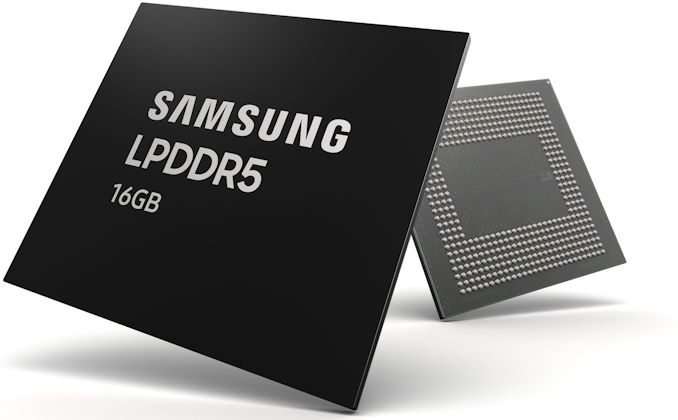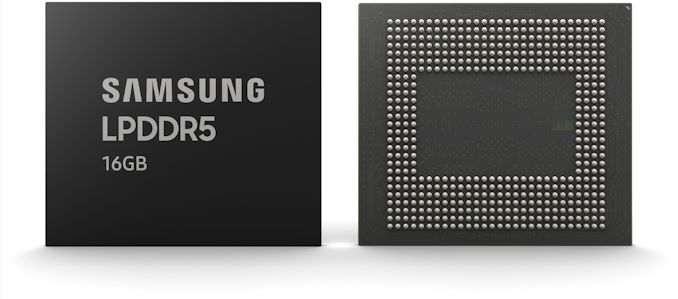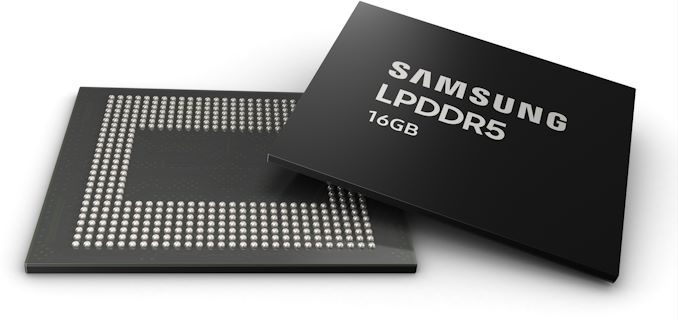Samsung Starts Production of 16 GB LPDDR5-5500 for Smartphones
by Anton Shilov on February 25, 2020 2:45 PM EST- Posted in
- Smartphones
- Memory
- Samsung
- Mobile
- LPDDR5

Samsung has begun mass production of the industry’s first 16 GB LPDDR5 memory for upcoming smartphones, such as the Galaxy S20 Ultra 5G handsets. The new DRAM devices not only offer higher capacity, but they are also 30% faster than previous-generation LPDDR4X-4266 used for previous-generation cellphones.
Samsung’s latest 16 GB LPDDR5 package consists of eight 12 Gb chips and four 8 Gb chips featuring a 5500 MT/s data transfer rate that can provide bandwidth of up to 44 GB/s. The very complex 12-device assembly is called a ‘mixed mode package’ because it contains DRAM devices that are accessed differently in different ranks. Samsung does not publish voltages of the new multi-chip 16 GB DRAM assembly, but only claims that it delivers more than 20% energy savings when compared to an 8 GB LPDDR4X package. Meanwhile, we do know that LPDDR5 memory chips feature a variable voltage that is up to 1.1 V.
The 12 Gb LPDDR5 devices are made using Samsung’s 2nd Generation 10 nm-class fabrication technology (also known as 1y nm), but the company does not disclose which manufacturing process is used to build 8 Gb LPDDR5 devices (though we are probably talking about 1y nm here as well).
Typically, DRAM makers make mass production announcements after they ship the first batch of products to a client. Considering that Samsung’s Galaxy S20 Ultra features 16 GB of LPDDR5 memory, it is more than reasonable to assume that it uses the company’s latest 16 GB LPDDR5-5500 DRAM package.
In the second half of this year Samsung plans to start production of 16 Gb LPDDR5 devices using its 3rd Generation 10 nm-class fabrication process (aka 1z). These chips will support speeds up to 6400 MT/s, but to take advantage of them Samsung will have to develop an SoC that supports such a high data transfer rate. Meanwhile, capacities of these upcoming LPDDR5 assembles remain to be seen.
Related Reading:
- Samsung Announces The Galaxy S20, S20+ and S20 Ultra: 120Hz, 5G, Huge Batteries, Crazy Cameras and $$$
- Micron Shipping LPDDR5 DRAM
- Samsung Starts Production of LPDDR5-5500 Devices: 12 GB of DRAM in a Smartphone
- Samsung Announces First LPDDR5 DRAM Chip, Targets 6.4Gbps Data Rates & 30% Reduced Power
- First with Snapdragon 865: ZTE Unveils Axon 10s Pro w/ 5G, 6.47-Inch AMOLED, 12 GB LPDDR5
Source: Samsung












33 Comments
View All Comments
nandnandnand - Tuesday, February 25, 2020 - link
"I've been looking forward to this."I didn't expect a mix of 12 Gb and 8 Gb chips, that is weird.
So what's next? 20 GB or straight on to 24 GB (such as 12x 16Gb)?
TeXWiller - Tuesday, February 25, 2020 - link
The DDR5 DIMMs will have two independent channels per DIMM, apparently.azfacea - Tuesday, February 25, 2020 - link
would i rather have 8GB of hbm2 in a flagship phone or 16GB LPDDR5? i mean better power, way more bandwidth .... its not like 8GB is not enough.The Chill Blueberry - Tuesday, February 25, 2020 - link
Phones are soon going to have more memory than storageyeeeeman - Wednesday, February 26, 2020 - link
Not really. Storage is already at 1tb and increasing. I don't see how ram could reach and overtake that figure in the next year or two.Santoval - Wednesday, February 26, 2020 - link
I believe Blueberry was jesting.29a - Wednesday, February 26, 2020 - link
For some reason Apple doesn't seem to have that problem. The XS gets by on 4 GB of RAM.Santoval - Wednesday, February 26, 2020 - link
The reason is (obviously) the very tight integration between iOS and hardware. That is not possible with Android due to the many phone and mobile SoC manufacturers.RSAUser - Sunday, March 1, 2020 - link
No, it's because for Android it's a marketing gimmick.My phone does fine with 4GB, would probably still be fine with 2/3GB for most users. Haven't suffered from windows reloading unless it's e.g. browser if it's been a couple of hours.
rmcrys - Wednesday, July 21, 2021 - link
Android doesn't cache near as much as iOS on the NAND flash / SSD or compress RAM. So it needs more RAM. I don't understand what is with the amount of RAM. If you pay 1000€ for an iPhone and works great with 4 GB RAM but high duration SSD, fantastic; if I pay 1000€ for my S20 Ultra with 12 GB RAM and it works also fine, why would I Care?! Same price, same end result.